
The right to live should be far more important than the right to work, and labor safety is the most crucial labor condition that the Group and its employees must jointly strive to maintain. As an employer, Eurocharm TW Xinzhuang factory does not meet the scale requirement stated in the Occupational Safety and Health Act, which mandates the establishment of an occupational safety and health management system for businesses with 200 or more workers in the first category of industries. Nevertheless, the Company has established internal procedures such as “The Procedure Book for Hazard Identification, Risk Assessment, and Determining Control Measures,” “Hazard Awareness Program,” “Work Environment Measurement and Sampling Strategy Planning,” “Automated Inspection Management,” “Employee Health Management,” “Contractor Safety and Health Operation Regulations,” “Change Management Operation Regulations,” and “Personal Protective Equipment Management.” However, internal and external audit were not conducted. VPIC1 in Vietnam has a safety office to implement an occupational safety and health management system. We comply with labor laws and regulations, fulfill our corporate responsibilities, and take care of and protect our employees. We have established safety and health/environmental policies and labor safety and health guidelines, and we hold labor safety and health meetings every quarter. Employees themselves should also be aware of and have an obligation to comply with occupational safety and health regulations that directly concern them to ensure their own safety at work. VPIC1 in Vietnam has obtained ISO 14001:2015 Environmental Management System and ISO 45001:2018 Occupational Health and Safety Management System certifications.
Safety and Health Policies
- Focus on global safety and health issues, assess risks, and build a safe working environment.
- Actively communicate and cooperate with customers and suppliers to improve the safety and health performance of our supply chain.
- Follow and comply with domestic and international laws and regulations, such as fire prevention, environmental protection, and safety and health laws.
- Continuously promote environmental safety and hygiene improvements to create a safe and healthy workplace.
- Identify blind spots and constantly improve through continuous auditing activities and safety and health management reviews to enhance operational safety and environmental quality.
Hazard Risks Assessment
Disasters are commonly perceived by the public as unexpected or unplanned catastrophic events. In fact, in safety management, the concept of a disaster involves a process that starts from the event caused by the disaster and proceeds through a chronological sequence to the outcome. Due to the numerous factory facilities and frequent human-machine interactions, implementing autonomous safety inspections to prevent equipment failures and human errors has always been a crucial issue in job safety. Eurocharm TW identified 1 high-risk item (forklift crushing injuries), 30 medium-high-risk items, and 20 medium-risk items in 2023. Regular retraining for forklift operators is conducted for high-risk items. Vietnam VPIC1 conducts regular identification of occupational hazards and risk assessments based on the “Hazard and Risk Assessment Procedure,” continuously and actively identifying hazards and assessing risks in various operational activities, products, and service processes for potential safety and health hazards. In 2023, 14 high-risk items were identified (such as elevator/crane cable or chain breakage, collision, brake hook to cable/chain, crushing injuries, electric shock, splash of mold/spring/parts, etc.), along with 62 medium-risk items and 15 low-risk items, to assess safety and health risks and opportunities, aiming for zero accidents. To implement our safety and health policy and achieve the requirements for continuous improvement, the Company continuously identifies hazards, assesses risks, and determines opportunities to eliminate or reduce safety and health risks. The monitoring of the work environment is to understand the true on-site condition and to evaluate the exposure status of the labor through planning, sampling, analysis, or measurement. Strategies must be developed accordingly to achieve such goal. In 2023, VPIC1 in Vietnam conducted an environmental monitoring on noises, respirable dusts, carbon dioxide, carbon monoxide, xylene, toluene, brightness, temperature, etc. by measuring 588 samples; among them, 444 samples of noises, respirable dusts, oxygen, carbon dioxide, xylene, toluene, brightness, and temperature met the standards, and 51 noise samples, 21 brightness samples, and 72 temperature samples failed to meet the standards. Lighting and ventilation were immediately improved, and the Company strictly required employees to use earplugs to reduce the impact of noise. Vietnam VPIC1 provides employees with earplugs and earmuffs and conducts regular special health checks for employees to ensure they receive proper care.
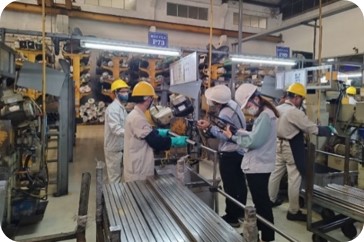
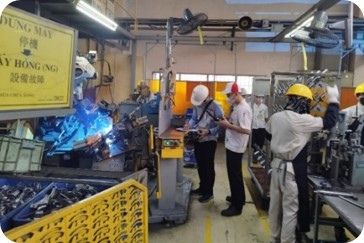
The Procedure of Risk Assessment
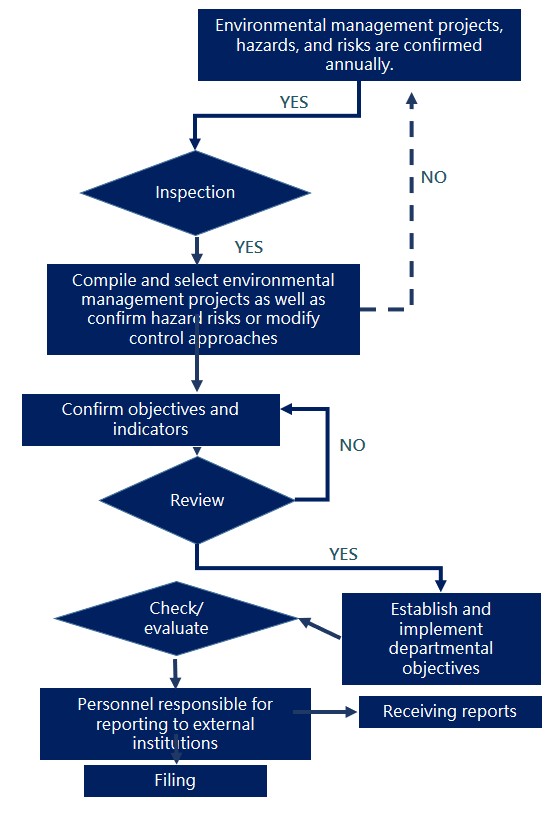
| Activity/ Equipment | Items with High Risks | Control Measures |
|---|---|---|
| Freight elevators/ Lifts | Falling of an elevator that injures employees | 1. Inspect according to the elevator and lift inspection checklist. 2. Equip freight elevators and lifts with warning lights during operation. 3. Install safety interlock devices. 4. Add a locking mechanism to the elevator control room. |
| Cranes | Cable or chain breakage | 1. Employees must undergo training and hold professional licenses. 2. Use protective equipment (safety helmets). 3. Inspect according to the crane inspection checklist. 4. Follow cable/chain load regulations. 5. Manufacture additional C-hooks with a load capacity of 5-7 tons. 6. Develop operation instructions for the hooks. 7. Conduct regular maintenance and safety inspections. |
| Cranes | Collision when moving products/materials | 1. Employees must undergo training and hold professional licenses. 2. Use protective equipment (safety helmets). 3. Equip cranes with warning lights during operation. 4. Regularly inspect, maintain, and replace damaged equipment to ensure safety. |
| Cranes | The crane cable/chain slipped out of the locking hook. | 1.Employees must undergo training and hold professional licenses. 2. Follow the Company’s crane operation regulations. 3. Inspect according to the daily crane and cable inspection checklist. 4. Regularly inspect, maintain, and replace damaged equipment to ensure safety. |
| Forklifts | Collision with people | 1. Employees must undergo training and hold professional licenses. 2. Follow the Company’s forklift operation regulations. 3. Inspect according to the daily forklift inspection checklist. 4. Install flashing lights, horns, and alarms. 5. When the drivers leave the vehicle, they must remove the key. 6. When the forklift is moving, maintain a safe distance of at least 60 cm from the assistant, and regularly inspect, maintain, and replace damaged equipment. Additionally, operators must participate in the annual forklift safety driving skills test. 7. Speed controlled at 5 km/h (inside the die-casting production line). |
| Shearing Machine | Entrapped/jammed boards | 1. Use protective equipment. 2. Issue safety cards to trained employees. 3. Follow the Company’s guidelines for the shearing machine. 4. Inspect according to the daily equipment checklist. 5. Regularly maintain and fix mechanical equipment. 6. Install fences and partitions between people and machines to isolate dangerous areas. 7. Create a workbench with rollers for placing materials and place corrugated iron supports behind the automatic machine. 8. Install fences and partitions around the corrugated iron cutting machine. 9. Secure the front cover with a lock. 10. Install sensors on the doors around the machine. 11. Add four stop positions to the fence. 12. Use strong pliers when cutting short materials. 13. Adhere to the stop-call-wait rule. |
| Punching Machine | Entrapped/jammed boards | 1. Install sensors. 2. Install dual-hand press device. 3. Install emergency stop buttons. 4. Install an operating device on each press machine, which can be switched to a 2-button or 3-button mode. 5. Eye examination chart, physical and mental health equipment, etc. |
| Punching Machine | Splashing of molds/springs/parts | 1. Provide protective gears: goggles, masks, etc. 2. There are protective shields around the molds. 3. There are protective shields by, in front of, and behind the machine. 4. Develop detailed instructions for mold disassembly and assembly. |
| Table Saw | Electric shock caused by electricity leakage | 1.Inspect according to the daily equipment checklist. 2. Keep the equipment tidy. 3. Use safety locks. |
| Deburring Machine | Entrapped/jammed boards | 1. Install electrical relay and safety sensor. 2. Install fences. 3. Interlock devices. 4. Lightning equipment. 5. Inspect according to the daily equipment checklist. 6. The supportive bars when changing molds. |
| Molds | Mold damages and splashing parts | 1.Employees must wear protective equipment (safety goggles) properly. 2. Adjust the stamping speed to approximately 18-20 SFM. 3. Inspect the mold before disassembly and seal it for confirmation from the supervisor. 4. Regularly maintain the molds. |
| Trucks | Collision with people or vehicles | 1. Comply with traffic safety regulations. 2. Follow the Company’s inspection guidelines. 3. Inspect according to the daily equipment checklist. 4. Regularly check, maintain, and replace damaged equipment. 5. Drivers must possess driver licenses. 6. Install dashcams. |
| Forklifts | Collision with people or vehicles | 1.lEmployees must undergo training and hold professional licenses. 2. Follow the Company’s forklift operation regulations. 3. Inspect according to the daily equipment inspection checklist. 4. Install flashing lights, horns, and alarms. 5. When the drivers leave the vehicle, they must remove the key. 6. When the forklift is moving, maintain a safe distance of at least 60 cm from the assistant personnel. 7. Regular maintenance and safety check. |
| Forklifts | Collision with people | 1. Employees must undergo training and hold professional licenses. 2. Follow the Company’s forklift operation regulations. 3. Inspect according to the daily forklift inspection checklist. 4. Install flashing lights, horns, and alarms. 5. When the drivers leave the vehicle, they must remove the key. 6. When the forklift is moving, maintain a safe distance of at least 60 cm from the assistant, and regularly inspect, maintain, and replace damaged equipment. Additionally, operators must participate in the annual forklift safety driving skills test. 7. Speed controlled at 5 km/h (inside the die-casting production line). |
Promote Culture of Safety and Build a Healthy Workplace
The Company values contractors as important partners. To ensure the safety of our contractors, each production site abides by the local occupational safety and health laws and regulations, reviews contractor construction plans, and requires suppliers or customers to wear protective equipment when entering the factory. We also promote various management mechanisms to strengthen contractor construction safety, such as complying with the table of contractor management (including equipment operation training records/professional licenses), and regularly or randomly inspect construction safety during construction processes. A contractor qualification review system is in place to classify contractors by their service projects while establishing a list of qualified contractors. This system will help procurement units to have an initial understanding of contractor backgrounds while also meeting practical needs such as improving the operation quality and construction safety standards. At VPIC1 in Vietnam, each production shift is assigned one safety officer, responsible for inspecting equipment and fire safety according to the checklist. The safety department conducts a weekly factory tour to identify deficiencies and reports them for on-site adjustments, and the feedback are provided upon improvements. The management department inspects one factory area each week, records deficiencies, and reports them for on-site adjustments. In 2023, Eurocharm TW took the initiative to conduct inspections on a total of 49 registered machines, all of which were carried out in accordance with Chapter 4 of the Occupational Safety and Health Management Regulations. Regular inspections were also conducted to ensure the safe operation of the equipment. Operators of hazardous equipment receive regular external safety and health education and training. In 2023, Eurocharm TW conducted labor safety education and training for employees, totaling 144 hours. The training content included labor safety management, operation of crane, forklift, overhead crane, as well as hazard risk analysis management, etc. A total of 28 employees participated, representing a 2.49% increase from the training hours in 2022. In 2023, VPIC1 in Vietnam conducted labor safety education and training for employees, totaling 9,084 hours. A total of 4,150 employees participated, with training content including general occupational safety training, crane operation, forklift operation, pressure equipment operation, chemical use, and firefighting. Referring to international regulations, customer requirements, and environmental trends, we have established a registry for 254 chemicals in use.
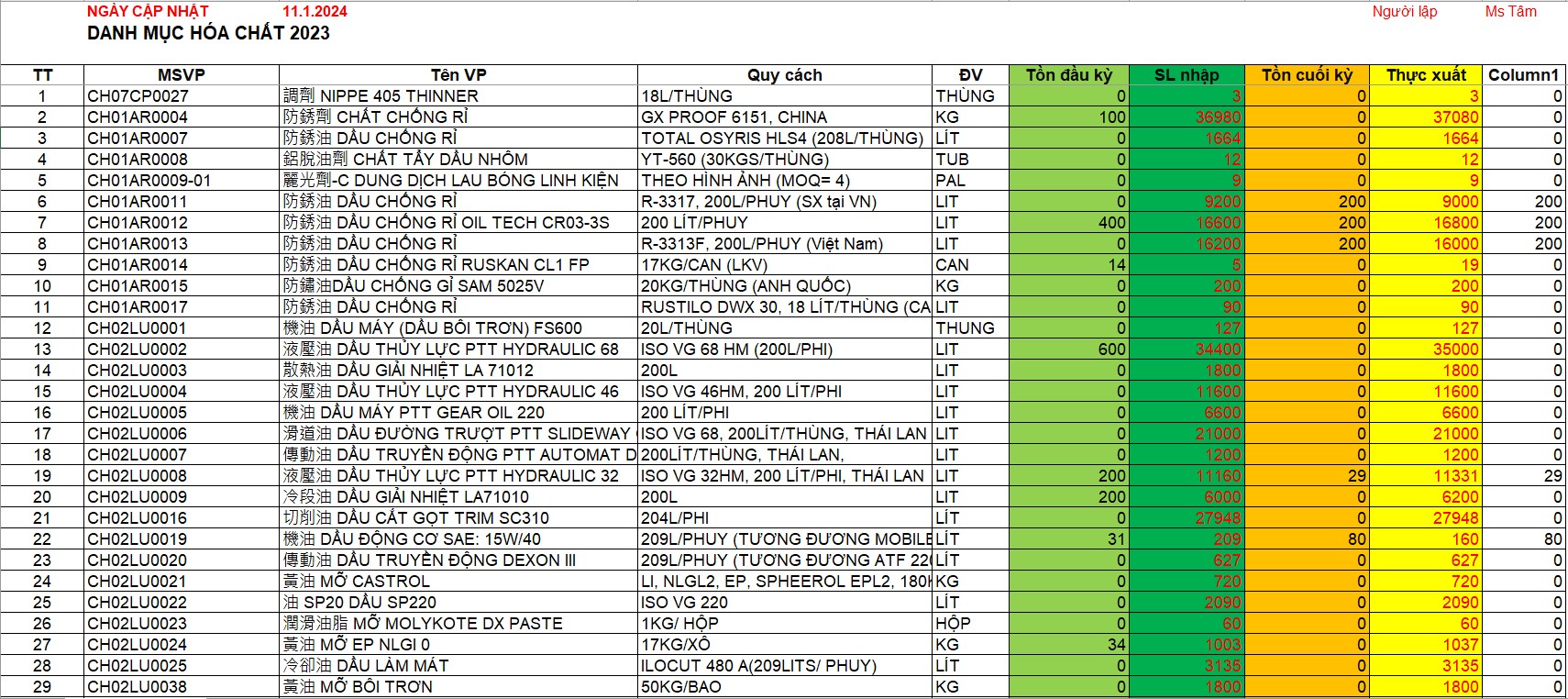
Safety Dojo (Training Center)
Vietnam VPIC1 has established a Safety Dojo at the Baishan plant. The term “dojo” originates from Japanese and refers to a training place. The Safety Dojo has become an excellent venue for employees to learn numerous important safety courses. The training conducted at the dojo mainly covers safety, quality, and environmental protection. Safety Dojo education is an experiential safety education method. By simulating scenarios such as being stroked by objects, fingers being caught in a stamping press, and safety shoes being crushed, employees can effectively combine “listening, observing, and doing” through watching, participating, and experiencing. This helps them gain a deeper understanding of the dangers and consequences of safety incidents and enhances their awareness of the importance of safety on an emotional level.
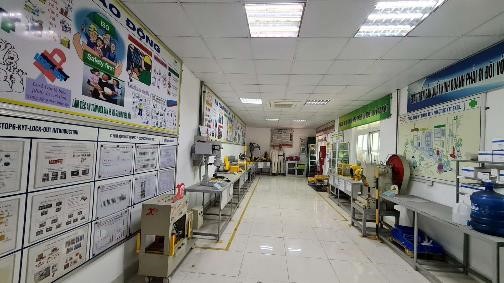
Notification and Investigation Mechanism for Occupational Hazards
Eurocharm TW and Vietnam VPIC1 supervise the handling of occupational accidents in accordance with local regulations, conduct statistical analysis of occupational accidents to promptly understand the status of employee occupational accidents. When an occupational accident occurs, the management department and occupational safety unit immediately initiate an accident investigation, conduct accident investigation analysis, and propose improvement measures. They regularly promote relevant safety and health matters to prevent similar situations from happening again. In 2023, there was 1 employee injury incident among suppliers, mainly due to crushing injuries. Vietnam VPIC1 experienced a total of 7 occupational accidents, mostly related to crushing injuries. Apart from establishing relevant operational regulations and enhancing education and awareness, necessary safeguards were also implemented for potentially dangerous machinery and equipment. Efforts were made to actively and properly handle injuries caused by employee accidents and assist employees in returning to the workplace.
The Investigation Procedure for Occupational Injuries

The Investigation Procedure for Fire Accidents
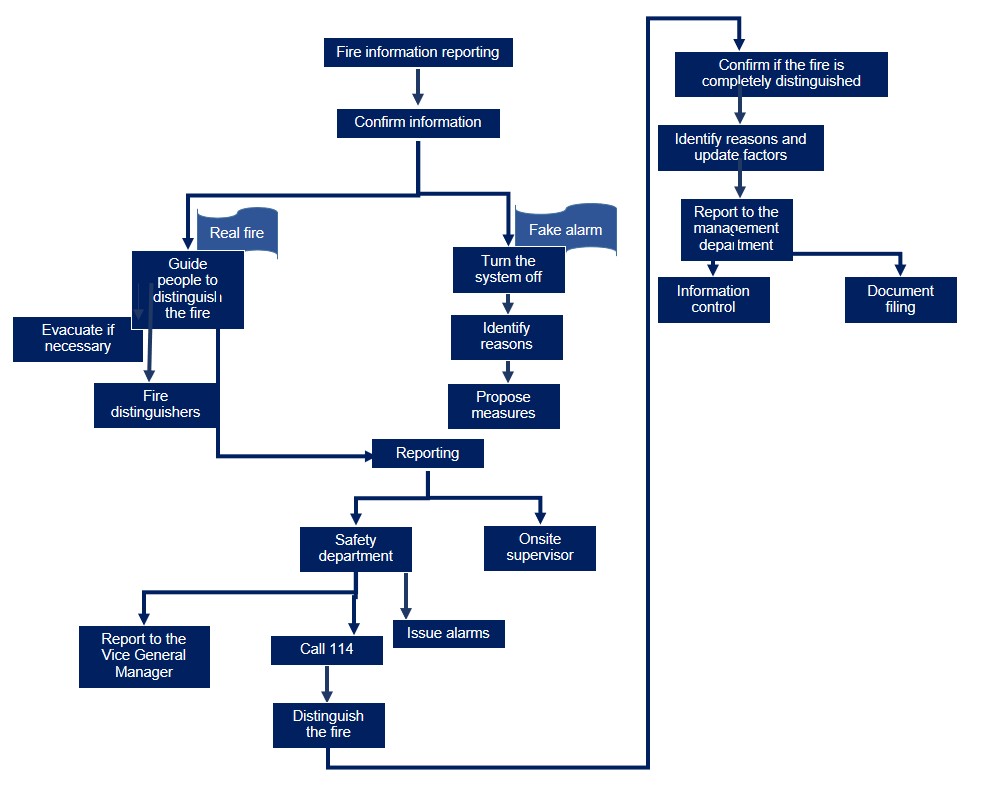
The Investigation Procedure of Chemical Leaks Accidents

The Investigation Procedure of Food Poisoning Accidents
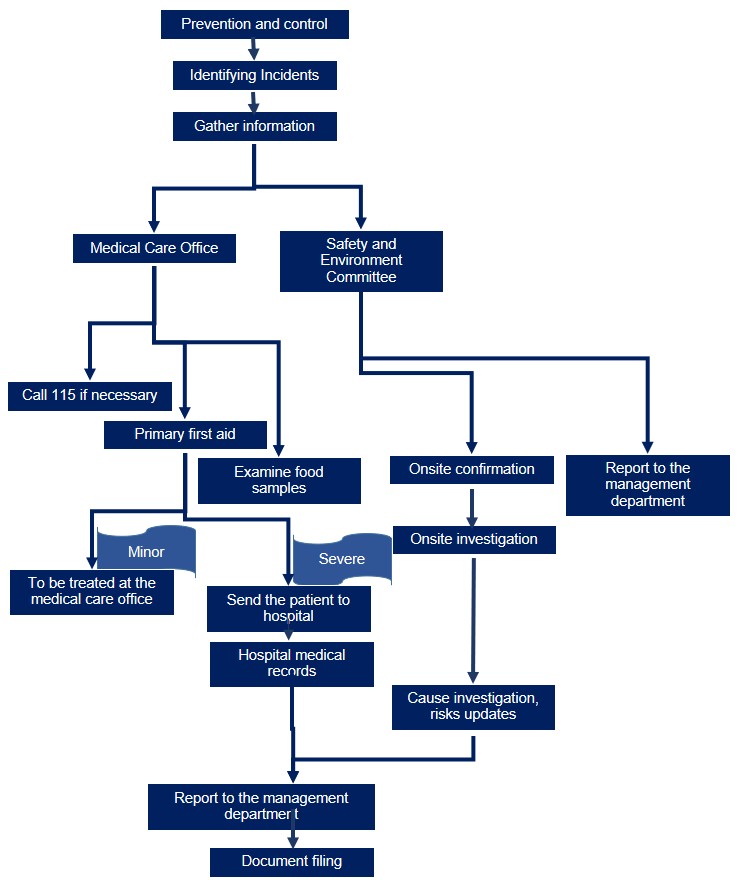
The Investigation Procedure of Contagious Diseases
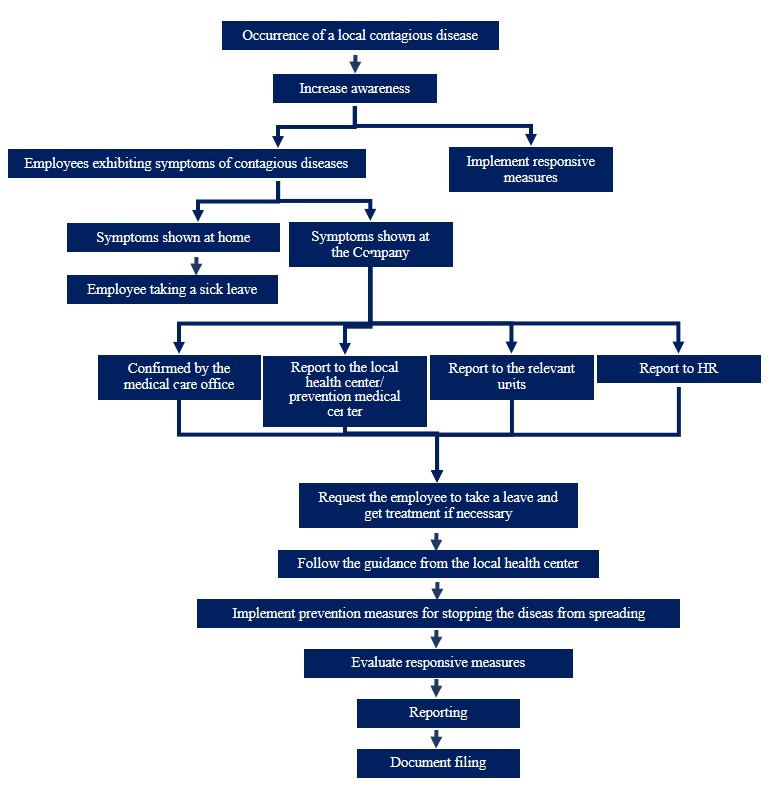
Statistics of Occupational Injuries in Taiwan
| Item | 2021 | 2022 | 2023 |
|---|---|---|---|
| Number of Occupational Injury Cases | 0 | 0 | 0 |
| Injury Rate (IR) | 0 | 0 | 0 |
| Lost Day Rate (LDR) | 0 | 0 | 0 |
| Number of Work-Related Deaths | 0 | 0 | 0 |
| Rate of Work-Related Deaths | 0 | 0 | 0 |
| Serious Injuries | 0 | 0 | 0 |
| General Injuries | 0 | 0 | 0 |
| Injury Frequency Rate (FR) | 0 | 0 | 0 |
| Injury Severity Rate (SR) | 0 | 0 | 0 |
(Note) The definition of serious injuries for Vietnam companies is events that caused disability.
(Note) The total working hours in Taiwan was 106,296 hours, the sum of the employees’ actual hours of attendance (including overtime hours).
(Note) Injury Rate (IR) = (the total number of occupational injury cases / total working hours) x 200,000.
(Note) Lost Day Rate (LDR) = (lost days/ total working hours) x 200,000. Lost days does not include the day of injury and the day of returning to work.
(Note) Rate of work-related death = the number of work-related deaths / total working hours x 200,000
(Note) Injury Rate (IR), Lost Day Rate (LDR), and the rate of work-related deaths are calculated based on 40 working hours per week, 50 weeks per year, per 100 employees.
(Note) Injury Frequency Rate (FR) = (number of disabling injuries throughout the year / total working hours) × 1,000,000
(Note) Injury Frequency Rate is equivalent to the GRI-defined recordable occupational injury rate.
(Note) Injury Severity Rate (SR) = (total lost days due to disabling injuries throughout the year / total working hours) × 1,000,000
Statistics of Occupational Injuries in Vietnam
| Item | 2021 | 2022 | 2023 |
|---|---|---|---|
| Number of Occupational Injury Cases | 6 | 9 | 7 |
| Injury Rate (IR) | 0.116 | 0.155 | 0.165 |
| Lost Day Rate (LDR) | 3.24 | 3.43 | 5.30 |
| Number of Work-Related Deaths | 0 | 0 | 0 |
| Rate of Work-Related Deaths | 0 | 0 | 0 |
| Serious Injuries | 0.0387 | 0.0690 | 0.118 |
| General Injuries | 0.0775 | 0.0863 | 0.047 |
| Injury Frequency Rate (FR) | 0.19 | 0.35 | 0.59 |
| Injury Severity Rate (SR) | 12.11 | 16.82 | 27.30 |
(Note) The definition of serious injuries for Vietnam companies is events that caused disability.
(Note) The total working hours in Vietnam was 8,461,602 hours, the sum of the employees’ actual hours of attendance (including overtime hours).
(Note) Injury Rate (IR) = (the total number of occupational injury cases / total working hours) x 200,000.
(Note) Lost Day Rate (LDR) = (lost days/ total working hours) x 200,000. Lost days does not include the day of injury and the day of returning to work.
(Note) Rate of work-related death = the number of work-related deaths / total working hours x 200,000
(Note) Injury Rate (IR), Lost Day Rate (LDR), and the rate of work-related deaths are calculated based on 40 working hours per week, 50 weeks per year, per 100 employees.
(Note) Injury Frequency Rate (FR) = (number of disabling injuries throughout the year / total working hours) × 1,000,000
(Note) Injury Frequency Rate is equivalent to the GRI-defined recordable occupational injury rate.
(Note) Injury Severity Rate (SR) = (total lost days due to disabling injuries throughout the year / total working hours) × 1,000,000
Statistics of Occupational Injuries of the Contractor Employees
| Item | 2021 | 2022 | 2023 |
|---|---|---|---|
| Number of Occupational Injury Cases | 0 | 0 | 1 |
| Injury Rate (IR) | 0 | 0 | 2.064 |
| Lost Day Rate (LDR) | 0 | 0 | 4.128 |
| Number of Work-Related Deaths | 0 | 0 | 0 |
| Rate of Work-Related Deaths | 0 | 0 | 0 |
| Serious Injuries | 0 | 0 | 0 |
| General Injuries | 0 | 0 | 2.064 |
| Injury Frequency Rate (FR) | 0 | 0 | 0 |
| Injury Severity Rate (SR) | 0 | 0 | 30.960 |
(Note) The definition of serious injuries for Vietnam companies is events that caused disability.
(Note) The total working hours for our Vietnamese suppliers are calculated as follows: an average of 170 vehicles entering the Company per day × 2 hours spent within the company × 285 working days = 96,900 hours, which is the sum of the employees’ actual hours of attendance (including overtime hours).
(Note) Injury Rate (IR) = (the total number of occupational injury cases / total working hours) x 200,000.
(Note) Lost Day Rate (LDR) = (lost days/ total working hours) x 200,000. Lost days does not include the day of injury and the day of returning to work.
(Note) Rate of work-related death = the number of work-related deaths / total working hours x 200,000
(Note) Injury Rate (IR), Lost Day Rate (LDR), and the rate of work-related deaths are calculated based on 40 working hours per week, 50 weeks per year, per 100 employees.
(Note) Injury Frequency Rate (FR) = (number of disabling injuries throughout the year / total working hours) × 1,000,000
(Note) Injury Frequency Rate is equivalent to the GRI-defined recordable occupational injury rate.
(Note) Injury Severity Rate (SR) = (total lost days due to disabling injuries throughout the year / total working hours) × 1,000,000
Employees’ Work-related Incidents
| Severity of the Injury | Description of the Incidents | Improvement Measures |
|---|---|---|
| Severe | On February 15, 2023, during the process of lifting I-beams onto a truck, an employee was adjusting the position of the I-beams on the truck. While lifting the last two I-beams, one beam was higher than the other, so the employee held the higher beam with his hand. At this moment, the crane began lowering the I-beams, and the employee did not remove his hand in time, resulting in his fingers being pinched and injured between the two I-beams. | Holding I-beams with hands is prohibited. Use tools instead. |
| General | On February 20, 2023, an employee was stacking molds; a mold at the lower place was with nitrogen springs, which prevented the upper and lower molds from fully jointing. When another mold was stacked on top, the weight caused the molds to joint with each other completely, and the employee’s fingers, which were positioned on the lower mold, were pinched and injured. | Establish a guideline for mold arrangement. Molds with nitrogen springs must be placed on the top layer, with no other molds stacked on top. |
| Severe | On March 23, 2023, an employee went outside the factory to move three empty carts, which were stacked together, for use. When passing by the track of the press machine, the carts got stuck, and the employee pushed forcefully, causing the third cart to slide off and injure employee’s fingers placed on the second cart. | 1. Manually pulling stacked empty carts is not allowed. 2, Proper equipment must be used when stacking carts, and a forklift should be used to pull them. |
| Severe | On April 13, 2023, an employee was operating a feeder machine to retrieve unused rolls of steel. The employee did not lower the pressure arm to secure the material but instead reached from the side to adjust the control wheel. At that moment, the roll of material loosened, and the edge of the material hit the employee’s face, causing injuries to the lips and nose. | Supervisors must assign personnel who have undergone relevant training for such tasks. |
| Severe | On June 17, 2023, an employee was assigned to clean up debris around tree roots. The employee borrowed a circular cutting blade and installed it on a manual grinding machine to saw the tree roots. The employee’s left wrist was cut when the blade caught the fabric of their woolen glove. | 1. Notify all employees that it is prohibited to modify tools without authorization or use tools without proper training. 2. Supervisors should implement active management and correct unsafe behavior of employees immediately. |
| General | On August 22, 2023, an employee used a pallet truck to pull back two stacking containers from the die-casting department. While turning after passing a slope, the wheels of the pallet truck hit the handle ring on top of a drain cover, causing the containers to tilt. Parts flew out and hit the head of an employee repairing a motor nearby. | 1. It is mandated that when employees use pallet trucks to move stacked containers, they must not stack them in two layers if the containers contain parts. 2. Improve the drain covers so that the handle on top does not protrude. |
| Severe | On November 17, 2023, an employee was painting a feeder of the punching machine. At that time, the machine was in a stationary state. When the work was almost finished, another employee started the feeder machine in preparation for production. The painter’s left hand was caught by the rotating coil clamping bar. | 1. When performing non-production operations on the machine, ensure that the power is locked to prevent others from starting it. 2. When starting the machine, ensure that there are no other personnel within the machine’s area. 3. Re-educate and promote the above safety operating procedures. |
Contractor Employees’ Work-related Incidents
| Severity of the Injury | Description of the Incidents | Improvement Measures |
|---|---|---|
| General | On August 23, 2023, the supplier DIAMOND was unloading goods at the plaza of Plant No. 1. A warehouse employee, #08419 Shang, was assisting with a forklift. During the process, the supplier’s truck driver, Huang, stood on the forklift’s front forks and accidentally had his hand caught and injured by the fork’s frame. | The Forklift Operation Procedure specifies that no one is allowed to stand on the front forks during operation. The forklift driver was re-educated on the relevant safety regulations. |



